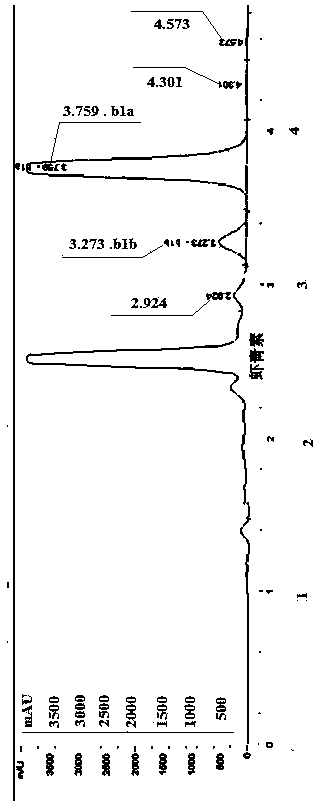Astaxanthin high-yield strain and application thereof
A high-yield strain, astaxanthin technology, applied in fungi, microorganisms, biochemical equipment and methods, etc., can solve the problems of inability to meet industrial production, low astaxanthin yield, etc., and achieve the effect of great social significance and economic value.
- Summary
- Abstract
- Description
- Claims
- Application Information
AI Technical Summary
Problems solved by technology
Method used
Image
Examples
Embodiment 1
[0035] Example 1 This example illustrates that Phaffia yeast ( Xanthophyllomyces dendrorhous ) The method of vr01 mutagenesis.
[0036] Phaffia yeast preserved in the laboratory ( Xanthophyllomyces dendrorhous ) vr01 is the starting strain, and the specific steps are as follows:
[0037] (a) In order to obtain a high-yield astaxanthin strain, after comparing various mutagenesis methods, the method of nitrosoguanidine (NTG) mutagenesis strain was selected. From Phaffia in liquid medium ( Xanthophyllomyces dendrorhous ) Obtain the cell suspension to be mutagenized in the vr01 culture. At 20 ℃ and 100 rpm, 10 8 The cell suspension of cells / mL was bathed in 250ug / Ml NTG solution 0.1M sodium citrate buffer, pH 5.0 for 60-120min. (B) Then the mutagenized cells were cultured in a liquid intermediate medium at 23°C and 100 rpm for 10 hours.
[0038] (c) Screening of mutagenic strains:
[0039] Screening: Connect the culture solution induced in step (b) to the seed culture medium, expand t...
Embodiment 2
[0043] Example 2 This example illustrates the high-yielding strain Phaffia ( Xanthophyllomyces dendrorhous ) VR-032 fermented production process of astaxanthin.
[0044] The medium formula used in this example:
[0045] The solid medium is: sucrose 3.0%, malt extract 1.0%, agar powder 1.5%, pH 5.8-6.0, and the rest is water.
[0046] The seed culture medium is: sucrose 4.0%, peanut meal 2.0%, potassium dihydrogen phosphate 0.2%, magnesium sulfate 0.05%, pH 5.8-6.0, and the rest is water.
[0047] The fermentation medium is: sucrose 2.0%, peanut meal 4.0%, potassium dihydrogen phosphate 0.2%, magnesium sulfate 0.05%, vitamin B 1 0.0002%, pH 5.8~6.0, the rest is water.
[0048] Inoculate Phaffia VR-032 on a solid medium at a temperature of 21°C and a culture time of 48h; inoculate the solid culture of Phaffia VR-032 into a seed medium, and fill the liquid in a 250mL culture bottle The amount is 30mL, the culture temperature is 21℃, and the rotation speed is 200rpm for 48h; the seed cul...
Embodiment 3
[0049] Example 3 This example illustrates the morphological, physiological and biochemical characteristics and passage stability of the mutant strain
[0050] Phaffia ( Xanthophyllomyces dendrorhous ) VR-032, the morphological, physiological and biochemical characteristics are as follows: colony color: off-white; aerobic mode: aerobic growth; colony size: 4~7 mm; optimum growth temperature: 22℃; suitable growth pH: 7.0~ 7.2; Cell morphology: round colony, dull; Gram stain: positive.
[0051] In the fermentation medium using sucrose as the carbon source (the fermentation conditions are the same as those in Example 2), the mutant strain Phaffia ( Xanthophyllomyces dendrorhous ) The output of VR-032, the passage stability during the observation period, and the strain passage fermentation test results are shown in Table 1:
[0052] Passages Astaxanthin production (mg / L)vr01 Astaxanthin production (mg / L) VR-032 F156.469.8 F255.870.0 F356.969.5 F456.769.3 F555.969.5
[0053] It can be...
PUM
 Login to View More
Login to View More Abstract
Description
Claims
Application Information
 Login to View More
Login to View More - R&D
- Intellectual Property
- Life Sciences
- Materials
- Tech Scout
- Unparalleled Data Quality
- Higher Quality Content
- 60% Fewer Hallucinations
Browse by: Latest US Patents, China's latest patents, Technical Efficacy Thesaurus, Application Domain, Technology Topic, Popular Technical Reports.
© 2025 PatSnap. All rights reserved.Legal|Privacy policy|Modern Slavery Act Transparency Statement|Sitemap|About US| Contact US: help@patsnap.com

